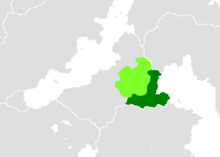User:Devink/Sandbox2
Grand Duchy of Yugstran Yug Nagherstran | |||||||||
|---|---|---|---|---|---|---|---|---|---|
| 1023–1919 | |||||||||
 Yugstran at its maximal extent in the Budyobyshevsk Commonwealth | |||||||||
| Status | Principality | ||||||||
| Religion | Orthodox Christianity | ||||||||
| Nagher | |||||||||
• 1023 - 1045 | Yarvos I | ||||||||
• 1250 - 1292 | Kando II | ||||||||
• | ... | ||||||||
| History | |||||||||
• Ikonkivoyra | 1023 | ||||||||
| 1919 | |||||||||
| |||||||||
The Grand Duchy of Yugstran was one of the two major kingdoms fighting during the Long Ikonkivoyra. Following the murder of Havar in 1020, duke Yarvos of Yugstran became the de-facto leader of the iconudlist resistance against the Sevromark. Instead of proclaiming himself King, like his rival Karro did, Yarvos instead upgraded his realm to a "Grand" Duchy for both political and ideological reasons.
Before the Ikonkivoyra, Yugstran was considered to be a second-tier territory inside the Kingdom of the Drev, overshadowed by the Duchy of Vizstran which was the real power on the right side of the Drev river, it's dukes being the real leaders of the Iconodulists Orthodoxs.
The history of Yugstran is traditionaly divided in three era: the Ikonkivoyra, the Budyobyshevsk Commonwealth, and the Triple-Crown. It was dissolved in 1919 with the abolition of the monarchy.
During the Ikonkivoyra, the Grand Duchy was in a state of war against the Sevromark and was slowly pushed eastward by the latter, losing its original lands south of the Drev and in the Yug and Viz bassins, but gaining the control of the eastern coast after a serie of successful campaigns. Despite its rather large armies and the existence of a permanent tax, the administrative reliance on feudal lords and the weakness of the central government permanently shaken by court intrigues left the Grand Duchy struggling to survive, owning its success to an handful of generals acting themselves as independent rivals of the Court and thus dangers for the Dukes. Yugstran won the war only through the help of the Budyobyshevsk Principality which intervened in their favour in exchange of the Grand Duke's submission. Under this agreement, the Grand Duchy reached its maximal extend, recovering all of its lost territories and gaining some more, and its Grand Duke also gaining the title of "Regent of Drevstran" from Budyobyshevsk.
As the domination of the Suvarov over its southernmost principality weakened, the Grand Duchy and its Ban of Drevstran became a point of friction between the Lushyodorstag and the Emperor. This culminate in 1690 with the death of the Grand Duke and the succession war fought by the two main claimants: Farza IV and Yaropolik. The death of Yaropolik at the battle of Angrast in 1694 and the convertion of Farza IV to the Orthodox Church marked the start of a personal union between the Lushyodorstag and Yugstran known as the Triple Crown.
History
Under the Commonwealth
Culture and economy
The early culture of Yugstran was characterized by a strong reaction to iconoclasm with a strong development of Icon and of the cult of relics. The lack of control over the Drev river also led to the isolation of the Grand Duchy until its conquest of the eastern coast.